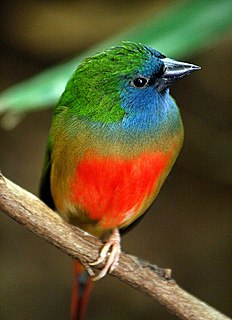
The pin-tailed parrotfinch is a common species of estrildid finch found in Southeast Asia: Malaysia, Brunei, Cambodia, Indonesia, Laos, Burma, Vietnam, Thailand and China. It has an estimated global extent of occurrence of 10,000,000 km2.
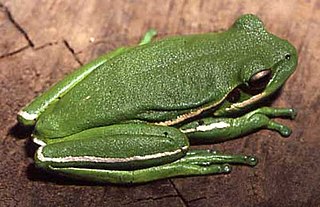
Boana prasina is a species of frog in the family Hylidae. It is endemic to Southeastern Brazil and known from the states of Minas Gerais, Rio de Janeiro, and São Paulo, and possibly further south. Common name Burmeister's treefrog has been proposed to this species.

Zamia chigua is a species of plant in the family Zamiaceae. It is found in Colombia and Panama. Its natural habitat is subtropical or tropical moist lowland forests.
Zamia disodon is a species of plant in the family Zamiaceae. It is found in Colombia and Peru. It is threatened by habitat loss.

Zamia fairchildiana is a species of plant in the family Zamiaceae. It is found in southeastern Costa Rica and Panama. In Costa Rica, it is found around the Sierpe River and Claro River, and on Burica Peninsula, Puntarenas Province. Its natural habitats are subtropical or tropical moist lowland forests and subtropical or tropical moist montane forests. It is threatened by habitat loss.

Zamia fischeri is a species of cycad in the family Zamiaceae. It is endemic to Mexico. It is often confused with Zamia vazquezii. Zamia fischeri is named after Gustav Fischer, a cycad enthusiast of the nineteenth century.
Zamia lacandona is a species of plant in the family Zamiaceae. It is endemic to Mexico, where it occurs only in the state of Chiapas, near Palenque and Agua Azul.
Zamia macrochiera is a species of plant in the family Zamiaceae. It is endemic to Peru. It is found near the towns of Pebas and Pucaurquillo in Maynas Province, Loreto Region; plants are found near the Rio Amiyacu and Rio Napo. It is threatened by habitat loss, and is considered critically endangered by the IUCN.
Zamia manicata is a species of plant in the family Zamiaceae. It is found in Colombia and Panama. Its natural habitat is subtropical or tropical moist lowland forests. It is threatened by habitat loss.
Zamia melanorrhachis is a species of plant in the family Zamiaceae. It is native to Colombia and Peru. It is known commonly as corocito.
Zamia montana is a species of plant in the family Zamiaceae. It is endemic to Antioquia Department, Colombia. Its natural habitat is subtropical or tropical moist montane forests. Zamia montana is extremely rare and is unknown in cultivation. Its habitat is also extremely threatened by logging activities. In fact, it may well be extinct in the wild because the only known population occurs in an area that was recently logged.
Zamia monticola is a species of plant in the family Zamiaceae. It is endemic to Guatemala. It is threatened by habitat loss.
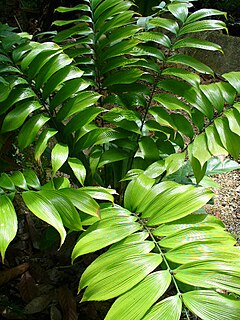
Zamia neurophyllidia is a species of plant in the family Zamiaceae. It is found in Costa Rica, Nicaragua, and Panama. It is threatened by habitat loss due to human presence.
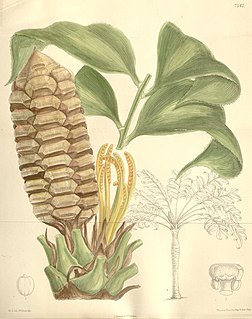
Zamia obliqua is a species of plant in the family Zamiaceae. It is found in Colombia and Panama. Its natural habitat is subtropical or tropical moist lowland forests. It is threatened by habitat loss.
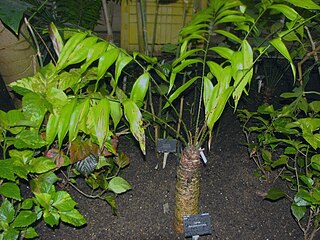
Zamia pseudomonticola is a species of plant in the family Zamiaceae. It is found in Costa Rica and Panama. Its natural habitat is subtropical or tropical moist montane forests. It is threatened by habitat loss.

Zamia pseudoparasitica is a species of plant in the family Zamiaceae. It is endemic to Panama. Its natural habitat is subtropical or tropical moist lowland forests on the Atlantic side of the isthmus. It is threatened by habitat loss.
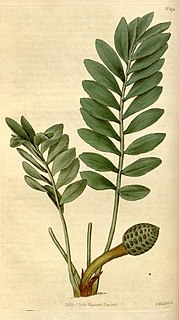
Zamia pygmaea is a species of plant in the family Zamiaceae found only in Cuba. It is the smallest living cycad. It is listed as critically endangered on the IUCN Red List based on its limited distribution, severely fragmented habitat, and population of less than 250 mature individuals.

Zamia standleyi is a species of plant in the family Zamiaceae. It is endemic to Honduras, and is threatened by habitat loss.

Zamia tuerckheimii is a species of plant in the family Zamiaceae. It was named after Hans von Türckheim, a German plant collector. It is endemic to Alta Verapaz, Guatemala. Its natural habitat is subtropical or tropical moist lowland forests. It is threatened by habitat loss.

Zamia variegata is a species of plant in the family Zamiaceae. It is native to Belize, Guatemala, Honduras, and Mexico. It grows in forests. It is threatened by habitat destruction, which has likely reduced the population by about 50% over the last few decades.













